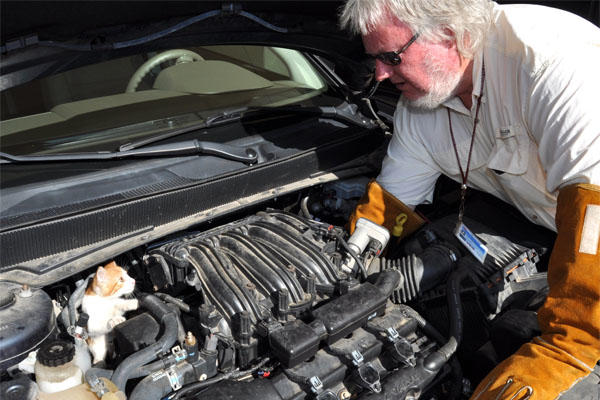Before you start to flush your cooling system yourself, it's really important to read this section in order to avoid endangering children and animals.
Caution: Anyone who has raised kids through the crawling and toddling stages knows that they tend to pick up the most revolting stuff off the ground and put it into their mouths. Because coolant looks and tastes good, a puddle of the stuff can be hazardous to children. That goes double for thirsty cats, dogs, and wildlife. Most coolant contains ethylene glycol, which is poisonous when swallowed. According to the EPA (Environmental Protection Agency), this chemical causes depression followed by respiratory and cardiac failure, kidney damage, and brain damage.
Eco-Logic: Although no coolant is completely nontoxic, some coolants on the market contain propylene glycol instead of ethylene glycol to reduce their toxicity. At least one brand has received the Seal of Approval from the ASPCA (American Society for the Prevention of Cruelty to Animals). However, even if you use this type of coolant, be sure to take the following steps to protect your pets and small children from accidentally drinking coolant:
- Make it a habit to check under your vehicle for coolant leaks.
If you find a puddle of colored liquid below the under-the-hood area and it isn't oily, it's probably coolant.
- Clean up any spills thoroughly.
Sop up all of it with kitty litter or absorbent rags, and then hose down the area thoroughly until the surface is clean. (Don't just hose it without sopping it up — you'll just be spreading the stuff around!)
- Dispose of the contaminated rags or kitty litter safely by placing it in a plastic bag, sealing it, and putting it in the trash.
- Store unused coolant safely.
The appropriate jugs have childproof lids, but you should still store them out of reach and away from heat, which can release toxic fumes.
- Store used coolant safely until disposal.
Pour used coolant into a container with a screw-on cap, label the container as "coolant" or "antifreeze," and place it well out of the reach of kids and pets until you can dispose of it, following the instructions in Step 6.
Caution: Don't put used coolant in containers that formerly contained beverages. They're too easily mistaken, and the sweet taste of the coolant can compound the error.
- Dispose of used coolant safely by taking it to a recycling center that handles toxic waste or a place that specifically recycles used coolant.
To find a place to safely dispose of used coolant, visit the Web site for Earth 911, www.1800cleanup.org/default.asp, or call your city hall or your local toxic waste management agency.
Tip: Some auto supply stores accept used coolant as a public service. Call the major stores in your area to find out whether they do so. If not, try a service station, which can either run the coolant through its recycling machine or include it in the batch sent out for safe disposal. Be prepared to pay for this service, though, because the service station didn't get to flush your cooling system for you.
The EPA has this advice about coolant disposal (they refer to it as "antifreeze"): "If your home is connected to a sanitary or municipal sewer system, household quantities of antifreeze can be flushed down the drain with plenty of water." However, the EPA warns that antifreeze can overwhelm the organisms in your septic system and damage the system, and it suggests that if your wastewater goes into a septic tank, you should dispose of antifreeze in a sanitary sewer system. The organization cautions, "Do not pour antifreeze into storm sewer openings, sinkholes, or abandoned wells."
Remember: If your engine boils over, be sure to clean up the spill wherever you are. Wild animals are just as vulnerable to being poisoned by coolant as domesticpets are.
From Auto Repair for Dummies, copyright © 2009 by Wiley Publishing, Inc., Indianapolis, Indiana. Used by arrangement with John Wiley & Sons, Inc.










